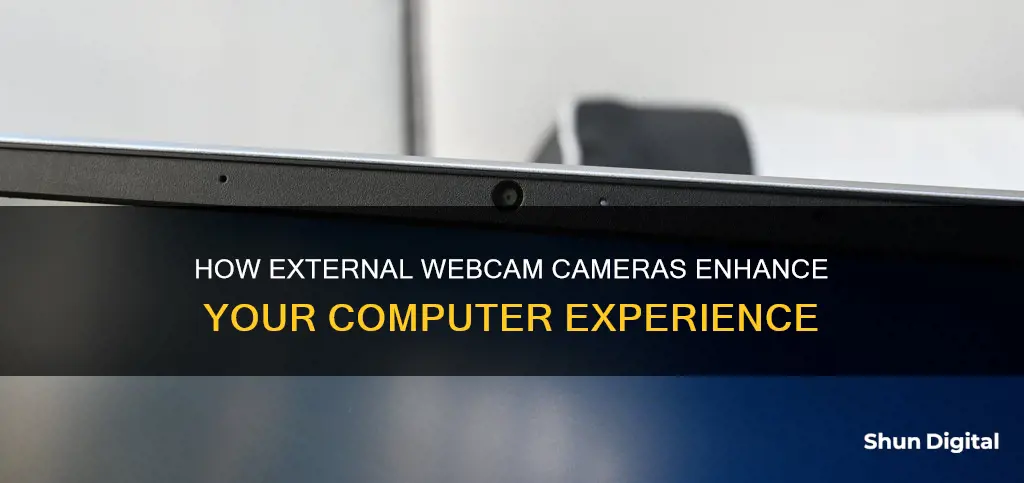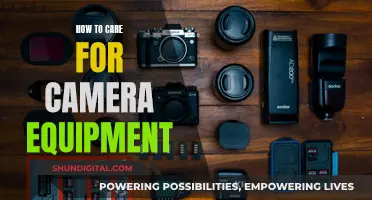
Computer cameras are a convenient way to take photos, make video calls, and more. However, they can also be a privacy concern, as they may be hacked and used for spying. This is called camfecting, and it involves hackers slipping remote-control malware into your device, giving them access to your camera and personal information. There are several ways to determine if your camera has been hacked, such as checking the camera indicator light, browser extensions, and running a malware scan. To prevent hacking, it is recommended to use a reliable antivirus program, avoid phishing traps, and cover your webcam when not in use.
What You'll Learn

The camera might be missing drivers after a recent update
If your camera is not working on your Windows computer, it might be missing drivers after a recent update. This is a common issue with many potential causes. Firstly, check your USB cable connection and try restarting your computer. If you're using a laptop, check if there is a shortcut for disabling the camera, as this could be pressed by mistake. Close any other apps that may be using your camera and ensure that your camera app is not running in the background.
If these initial checks don't help, try the following:
Check the Camera Isn't Hidden in Device Manager:
The Device Manager gives users the option to hide devices. If you don't see the Camera device, it might be hidden, so you need to unhide it.
Run the Camera Troubleshooter:
There is a built-in Camera troubleshooter on Windows that can help identify and fix camera-related problems.
Download the Camera Driver Manually:
When a driver gets corrupt, or you mistakenly uninstall it, Windows should automatically reinstall it when you restart your computer. If not, you should manually install it. Go to your laptop manufacturer's website, search for the latest camera driver, download and install it.
Allow Camera App Access:
For the Camera app to function, it must have permission to access your device's camera. Ensure this permission is enabled.
Reset the Camera App:
If you've recently modified the camera app's settings and are now experiencing issues, reset the app. You won't lose any data, but you will need to customise the app from scratch.
Add the Camera Device in Device Manager:
The Device Manager allows users to manually add devices that aren't detected automatically by the system. You can do this via the Add Hardware wizard.
Get Your Laptop Checked:
If none of these fixes work, there may be a hardware issue, so you should take your laptop for an inspection. If your device is still under warranty, get it checked by the manufacturer.
Choosing the Right Charger for Your Camera: A Guide
You may want to see also

An antivirus program could be blocking the camera
If you believe your antivirus program is blocking your camera, you can try disabling the program temporarily and then using your camera. If your camera works after doing this, you can be sure that your antivirus program was the issue. To avoid this problem in the future, you can add a new exclusion in your antivirus software settings.
If you are using Windows Defender, you can do this by opening the Windows Defender Settings, selecting Virus & Threat Protection, going to Virus & Threat Protection Settings, and clicking "Add or Remove Exclusions". Then, select the application you want to have access to your webcam.
Other antivirus programs may have different processes for allowing camera access. For example, if you are using ESET HOME Security Essential, you can launch ESET, click "Setup", select "Network Protection", click the slider bar next to "Firewall", and select "Pause until reboot". This will pause the ESET firewall until you restart your PC.
Adjusting Your Logitech Camera to Disable Auto Focus
You may want to see also

Privacy settings don't allow camera access for some apps
If your privacy settings don't allow camera access for some apps, it could be due to a few reasons. Firstly, you may need to give the app permission to use your camera. When you open an app that wants to use your camera, you should receive a notification asking for permission to access it. You can then choose to "Allow" or "Deny" this request. If you denied access previously, you can change this setting in the app's permissions.
On an Android device, open the Settings app, tap the app you want to change, and then tap the permission setting to change it. For iOS devices, go to Settings, then Privacy, then Camera, and turn on the setting for each app you want to give access to.
For Windows 11, go to Start > Settings > Privacy & Security > Camera, and ensure "Camera access" and "Let apps access your camera" are turned on. Then, turn on camera access for the specific app. If you can't change the setting, you may need an administrator to change it for you.
Another reason your camera may not be working is that your device is missing drivers after a recent update. To fix this, check for updates and install any available updates for your camera. If this doesn't work, try restarting your device, as this could fix any minor glitches.
If you're using an external camera, try using a different USB port on your device. If your camera is built-in, try scanning for hardware changes in the Device Manager. If your camera still doesn't work, you may need to roll back or uninstall your camera driver and scan for hardware changes.
The Making of the First Kodak Camera
You may want to see also

There is a problem with the app you want to use
If you're having issues with your camera on Windows, there are several things you can try. Firstly, check if your camera is working with the Camera app. Select Start, then choose Camera from your apps. If you're asked to allow access to the Camera, select Yes. If the camera works in the Camera app, the problem might be with the app you're trying to use.
If your camera is not working in the Camera app, there are several other things you can try. Here is a list of troubleshooting steps you can follow:
- Check for updates. Select Start > Settings > Windows Update > Check for updates. If there are no updates for your camera, try to select Advanced options > Optional updates, and look for any driver updates for your camera. Allow available updates to install, then restart your device.
- Restart your PC. If you haven't restarted your device since the camera stopped working, you should do so. Select Start > Power > Restart. Waking up your device from sleep is not the same as a restart.
- Check for a camera switch or button on your device. Some laptops and portable devices have a physical switch or button that turns the camera on or off. When it's turned off, your device may not recognize that there's a camera installed, or it may cause your camera to show an image of a camera with a line through it. If your laptop has a switch or button, make sure it's in the on position before using your camera. These switches or buttons may be hard to find, so check all possible places, including a button on the keyboard that's activated with the Fn key, a dedicated camera button on the keyboard, a sliding switch on the side of a laptop, or a small slider for a shutter built right into the camera.
- Give your apps permission. If you recently updated Windows, you might need to give apps permission to use the camera. In newer versions of Windows, some apps won't have default access to the camera. Here's how to let your apps access the camera: Select Start > Settings > Privacy & security > Camera. Allow access to the camera on this device. Make sure Camera access is turned on, and choose which apps should have access. Only apps that were installed from the Microsoft Store will appear in this list. If you're having problems with an app that you did not install from the Microsoft Store, make sure that Let desktop apps access your camera is turned on. Internet browsers and many video conferencing apps are desktop apps that require this setting to be turned on.
- Check your antivirus software. In your antivirus software settings, look for settings that block access to your camera or permission to use your camera. For help, visit your antivirus software company's website.
- Check your hardware drivers. If you're using an external camera, try using it with a different USB port on your device first. If that doesn't work, or your camera is built into your device, try this: Select Start, type device manager, then select it from the search results. Find your camera under Cameras, Imaging devices, or Sound, video and game controllers. If you can't find your camera, select the Action menu, then select Scan for hardware changes. Wait for it to scan and reinstall updated drivers, restart your device, then open the Camera app again to test it.
- Roll back the camera driver. If your camera stopped working after an update, try these steps: In Device Manager, right-click (or press and hold) on your camera, then select Properties. Select the Driver tab, select Roll Back Driver, and then choose Yes. After the rollback is complete, restart your device, and then try opening the Camera app again.
- Uninstall your camera driver and scan for hardware changes. In Device Manager, right-click (or press and hold) on your camera, and then select Properties. Select the Driver tab, then select Uninstall Device. Select the checkbox for Attempt to remove the driver for this device, then select OK. In Device Manager, on the Action menu, select Scan for hardware changes. Wait for it to scan and reinstall updated drivers, restart your PC, and then try opening the Camera app again.
- Switch to the UVC driver. Most available USB webcams are UVC (standard USB Video Class) compatible cameras. They will work with the UVC driver that is included in Windows. If your webcam is not working correctly, swapping to the UVC driver may resolve the issue. Please follow the steps below to change drivers (admin rights are required): Select Start, type device manager, then select it from the search results. Find the problem webcam from the list of devices shown in the Device Manager. It should appear either under Cameras or Imaging devices. Right-click the webcam device and select Update driver. Select Browse my computer for drivers. Select Let me pick from a list of available drivers on my computer. Select USB Video Device and then select Next to complete the driver update. Select Close to acknowledge settings choices and go back to Device Manager. The webcam will now appear under the Cameras category in the Device Manager list.
If none of these steps resolve your issue, you can try searching for similar problems in the Microsoft Community forum or use Windows Feedback Hub to report an issue and get help from Microsoft.
The Evolution of Contax Cameras: A Global Journey
You may want to see also

The camera has been hacked
The idea of someone hacking your camera and spying on you is not just a Hollywood plot. It is a real threat that you should be aware of and take steps to prevent. Here are some ways to know if your camera has been hacked:
- Check if the camera indicator light is on or blinking, even though you haven't turned on the webcam.
- Reboot your computer and launch your browser. If the webcam light turns on, the problem is likely a browser extension.
- Check your applications. Launch an application and see if the webcam indicator lights up.
- See if your webcam process is running. Go to the Task Manager and look for all currently running programs under the "Processes" tab.
- Try running the webcam. If you get an error message stating that your camera is already in use, it might be hacked.
- Look for audio and video recordings you don't remember. Go to the folder where your webcam stores files.
- Run a malware scan. If unfamiliar software is using your camera, scan your system for malware and move the file to quarantine.
If you suspect your camera has been hacked, it's important to take action immediately. Change your passwords, update your security software, and consider seeking help from a tech professional. Additionally, covering your webcam with tape or a sliding cover when not in use is an easy and reliable way to prevent someone from watching you.
Surveillance Cameras: Privacy Intrusion or Security Essential?
You may want to see also







